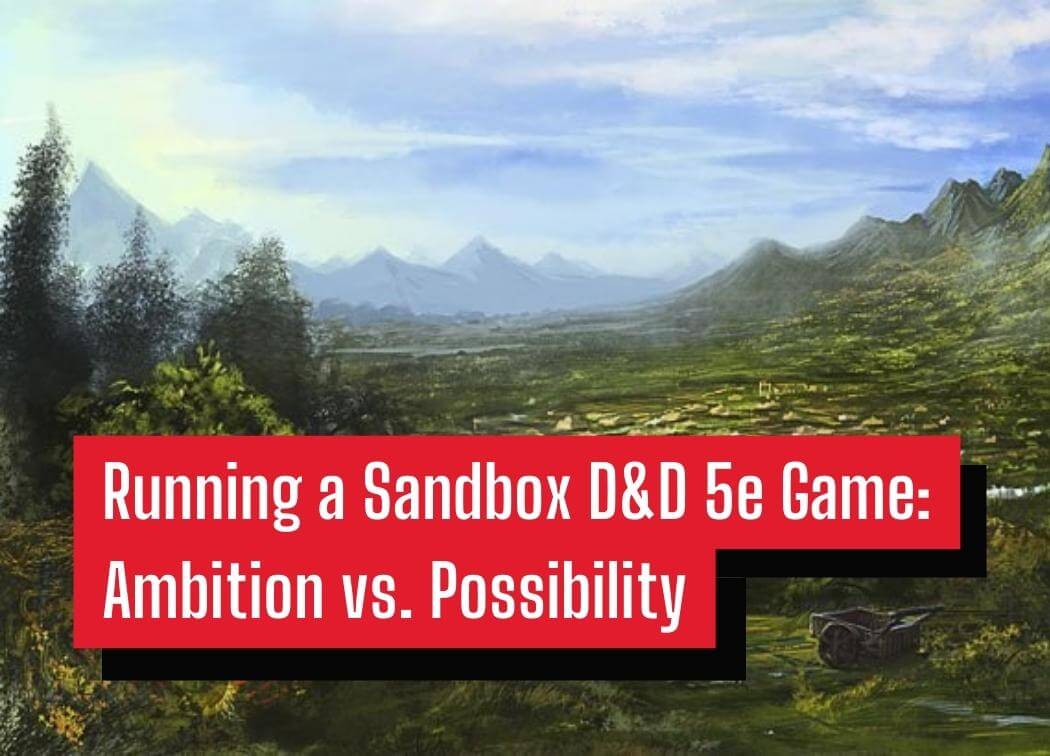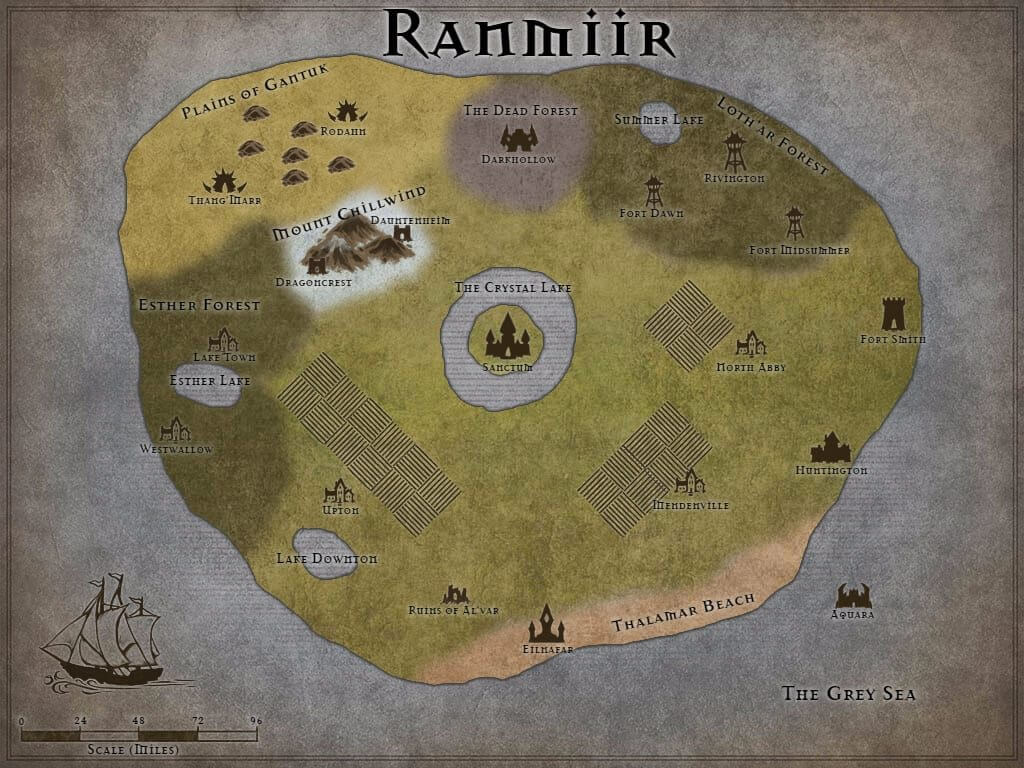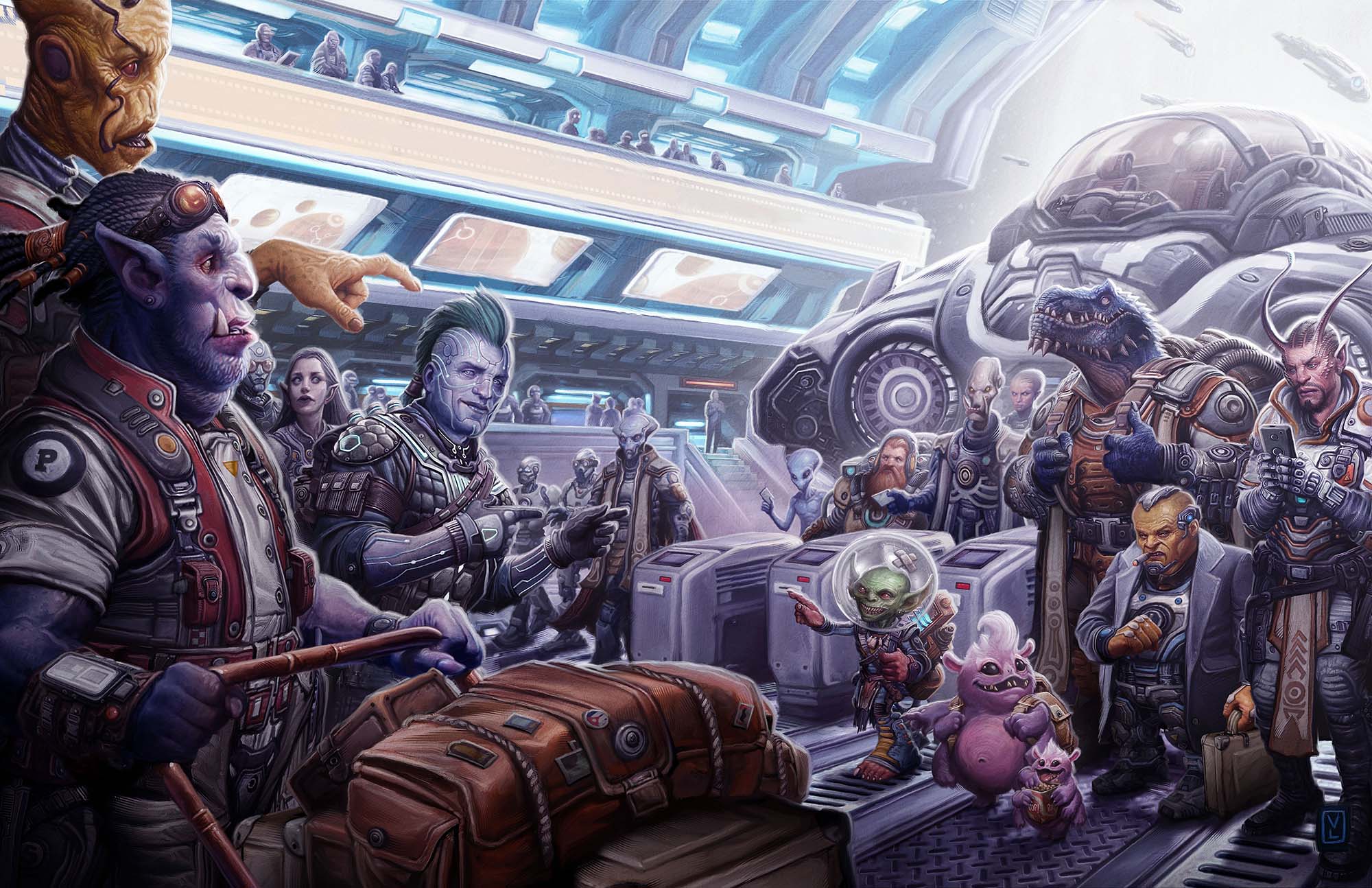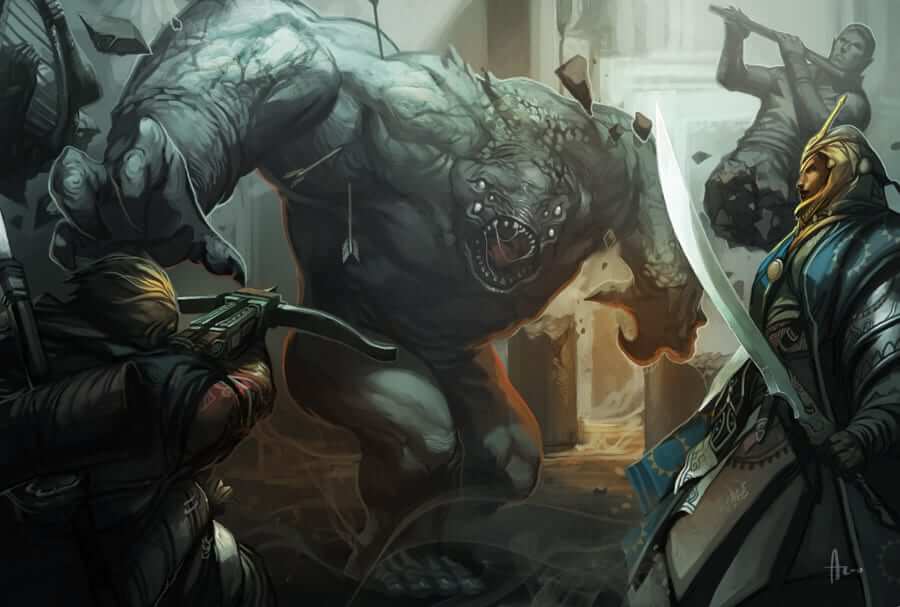Running a Sandbox D&D 5e Game: Ambition vs. Possibility

In the past whenever I’ve tried to “sell someone” on playing D&D compared to a video game the words “you can do ANYTHING” are always inserted into the conversation.
It’s true in general and it’s true in my games. However, while many start out as a sandbox D&D game where anything is possible, eventually the game will slowly turn more linear. It’s difficult to run a true sandbox game and it’s difficult to play in one.
What is a Sandbox D&D Game?
A true sandbox D&D game will consist of a world, lore, and cities just like any other D&D game. The difference is how the party explores the world and discovers quests and plot hooks. In a more linear D&D game the party will typically have some direction towards their next task. The DM may also give hints or have NPCs approach the party to help further the plot.
In a sandbox game, the players will have to explore and talk to people to find their next mission. They have to find the story as opposed to the story finding them. The players will decide what they want to do, where they want to go, and of course, how they want to do it. The DM will have to be very hands-off and only give them directions if they directly ask an NPC for them or receive a quest from an NPC.
However, this doesn’t mean that there is no overarching story or big bad villain. Look at games like Skyrim which are both sandbox RPGs, but also have a main story-line for the player to complete. A sandbox D&D game is the same way. The players can choose to follow the overarching story, completely avoid it, or anything in-between. This is the main difference between a linear game and a sandbox game.
The World as a Sandbox
As you can imagine, running a sandbox game is an extremely ambitious task. Letting the players loose in the world will require you to actually have a world to let them run wild in. I’ve spoken about prep time before, but with a sandbox D&D game, you’ll want to spend a lot more time in the initial preparation stage than you would for the average D&D 5e game.
Everything needs to be fleshed out. You need interesting cities, towns and villages, plenty of NPCs with desires and ambitions, and rich lore for the players to uncover. Does this sound like a lot of work? It is, but on the bright side, the more you do now the less you’ll have to do later.

Cities, Towns, and Villages
While in video games cities, towns, and villages are basically big quest hubs, in a D&D sandbox game they’ll serve that same purpose and more. These are the vessels for telling a good story in a sandbox. Each location should have a unique culture or something that sets them apart from the others. Every location needs to have something different that will draw the players towards visiting and interacting within it.
You’ll also want a map that will detail areas of interest for the players. Locations like taverns, government buildings, shops, and important businesses should be labeled on the map. This helps your players make informed decisions on where they’d like to look for their next mission or explore the town to learn more about its culture.
Another thing I like to do is make a player handout for each city, town, and village. This handout has basic information about the location such as primary race, religion, population, and short descriptions of each area of interest. I then keep any plot hooks, NPC information, and other DM knowledge in a separate document that only I can look at.
While these are good tips for any type of game, but for a sandbox game, you’ll want to make sure your cities, towns, and villages are well-made and interesting. They should be open-ended and filled with life, interesting culture, and unique experiences. Build your world well and let the players run wild in it.
I’ve written a 2 part series on creating interesting cities, towns, and villages if you want more information on this subject. Check out part 1 here!
NPCs
NPCs are very much like your cities, towns, and villages in a sandbox game. They help you tell the story and explain the world to the players through rumors and oral storytelling. They’re also the primary way that your players will interact with the world around them.
Important NPCs will get a small note card-sized blurb. It will explain their appearance, ambitions, and some quirks or mannerisms. I’ll reference these blurbs when the players interact with that particular NPC so that I can establish the differences between each one and convey their story in their personal biases.
You don’t have to do voices to make an NPC unique. I’m not talented in this area, but my players have still latched on to many NPCs despite my lack of voices.
Not every NPC is going to be important and deserve a blurb about them. For throwaway NPCs I make a list of names cross them off as they’re used. This is also a great way to explore different cultures as I can have a list of elf names, dwarf names, and human names to help contrast the differences between the cultures.
Some big cities may be heavily integrated and you’ll have humans with dwarven names. Names are a big part of worldbuilding!
Lore
The lore of the world is going to be very important depending on the campaign. In a sandbox D&D game, this is basically the foundation of the entire game. Heroes, villains, and tales of deities shaping the world around them will influence so much of your campaign.
Stories and treasures that tie back into the lore of the world can give birth to plot hooks and new cultures. Both of these things are cornerstones of running a great sandbox D&D game. Anything that encourages the players to explore the world naturally without provocation from the DM is a huge win. Finding an ancient hero’s sword in a dungeon leads way to learning more about that hero and their exploits, and maybe finding some loose-ends that they left hanging after their death.
Religion in D&D is a huge part of the lore. Deities, cults, and festivals are all great outlets for religion and will give your players something to interact with and explore within the setting. Individuals or groups of people may choose to worship certain deities over the others. Delve into why and how. Flesh it all out so that your players have something to discover and learn about that portion of the world.
Timelines are particularly useful for organizing a large-scale history of your game. These major events will be things that sparked the world around them. Cities were built and destroyed and people lived and died. What this means is that there are now more things for your players to explore! While I haven’t used it yet due to my initial campaign prep being 2 years old at this point, World Anvil is an excellent and highly regarded tool for just this.
Storytelling in a Sandbox D&D Game

Developing a story in a sandbox game is much tougher than doing so in a linear game where you can gently guide your players in the right direction towards an interesting story or a new mission.
In a sandbox, you need to be passively telling the story. Use your NPCs to hand out quests, showcase local problems, and talk about the world around them. The players will have to decide if they want to interact with these issues. Sandbox games are about having tons of options and decisions.
You’ll want to have a main story-line planned out with a villain and major events. These events and villains should be able to be affected by the party’s actions. From there, plot out offshoots and stories that the party may discover if they travel down separate paths like side quests and missions.
Speaking of offshoots, be sure to use backstories of each of the PCs as well! Having something relevant to their character’s background is probably the best way to ensure that a player will want to explore an area. They’ll learn more about their character while they learn more and interact with the world.
What if the Players Don’t Interact with the Main Villain?
This is an actual mechanic in Apocalypse World among other systems. If the never finds the villain or chooses to not interact with them the villain simply continues with their plan. Just because the party is off doing side quests does not mean that the evil wizard will not open a portal to the abyss and let demons flood the surface world.
As things get worse in the world your players may be enticed to act in a way that will stop the villain’s plot. They may even join them depending on their play style. Showcase what is happening to the world because of them avoiding their fate. Eventually, they’ll have to make a decision to either act or suffer the consequences.
I’d say this isn’t an issue 99 times out of 100. The players know that there is a reason they’re playing in this time period and are excited to find out why and what they can do about it.
Side Quests, Side Quests, and More Side Quests!
As you can probably gather from this post so far, sandbox D&D games are there to promote and reward exploration of the world. Not everything in the world is going to focus on thwarting the plans of the big bad villain. In fact, very little of it will, especially in the early levels. Side quests can be self-contained stories about a town or person and can give some great insight into the plight of the common person.
These side quests are going to be a big way of interacting with NPCs and different locations in the world. Everyone has problems and they will gladly pay adventurers to solve them for them. Goblins in a cave, a caravan that needs guarding, a person that needs finding, or an item that needs to be delivered. All of these can be used as vessels for exploring the world and learning a bit more about it.
Side quests don’t have to be completely separate from the main story. They can be adjacent or be focused around dealing with the outcome of a consequence of the main story. However, for a game to feel truly open world these should be in the minority of your side quests. They should be quick stories or encompass a single quick errand, but each one should build the world a little bit better for the party.
Basically, keep making side quests. Have a great variety and make some really unique ones. Your big capital city should not only have 1 person with an issue or a job for a group of adventurers. If you don’t use them now keep them somewhere for your next D&D game. Don’t be afraid to pull from adventures and other supplements to help you cut down on prep time too!
Tons of Preparation Required

With the amount of world-building you’ll have to do you’ll have a ton of work to do before the campaign even begins. Combine the worldbuilding with the creation of plot hooks and side quests and you have a big project.
The amount of prep time required is probably the biggest factor for why many games that start out as true sandbox-style games quickly become more linear as the games go on. It’s a huge task to make more things for the players to interact with.
Sandbox D&D games tend to last a lot longer than more linear games as there is not always a clear end in sight. In these types of games, players will find many ways to entertain themselves or explore side stories that aren’t related to the main game. These offshoots will take up very little in-game time. However, they will take up a few sessions in real life time and extend the life of the game.
As a DM for a game like this, you’ll be tethered to it for quite some time. Obviously, you will have to keep working on it. Thankfully, the more that you did in your preliminary prep will save you a lot of time down the road. All you’ll need to do in-between sessions is plan out the main story as new plot elements emerge and maybe throw some new side quests together.
Some Ways to Cut Down on Prep Time
Use pre-written adventures and modules for side quests to cut down on prep time. The most work that using these will require is potentially creating battle maps and tweaking things to fit your setting or balance for your party.
If your players are up for it see if they’d be interested in doing the world building together! I’ve thought about giving each player a major city to design and then I’ll later fill it with my quests and events that are tailored towards what they create. On a smaller scale even going over what they want as a major theme for the campaign in a session 0 is immensely helpful.
Conclusions
My current long-term campaign is probably the closest I’ve ever been to a sandbox D&D game, and it’s still pretty far from the mark. In many cases, this is because while we say we want a true sandbox game where we can do anything we actually want some form of direction. We want to experience a story and find a dungeon, and not find a quest to find the dungeon. This post from DM David summarizes this conundrum very well.
That being said, every D&D game should have some sandbox elements even if they are actually pretty linear games. Players should always be able to interact with the story and the world freely. This is healthy and what most games I run and others run are.
Players will find ways to solve a puzzle or beat an encounter that you had not anticipated. They will ask questions and learn information from NPCs that you’ll have to completely make up. At this point, I probably have a second campaign’s worth of unused side quests. This is natural and can save you some time prepping future games!
While my current campaign will probably last at least another year of real-time play, we’ve already thought up our next big game. For now, it’s a West Marches inspired sandbox style game that will have multiple PCs per player to form a guild. I’ve slowly began drafting ideas for how to run this, so expect some more posts like this one in the (distant) future!

“With the amount of world building you’ll have to do you’ll have a ton of work to do before the campaign even begins.”
Hasn’t been my experience. I have been running a sandbox open table since Jan 2017. My initial prep was about 2 hours which involved drawing a 10 mile per map hex grid 100 miles across with terrain and a few cities named. Plonking 5 dragon lairs down and deciding the elves and orcs had long ago lost their empires in a terrible war and were remnant peoples now. The main town had a main product of timber and dwarves in the north traded gems and iron to the south where furniture and weapons were made. And a quick random encounter table to just throw things in front of players.
My first players were told some lizard folk were being mean to elves in the south. The players made elf characters who were outlaws and invented a local lord who became the evil ruler everyone has hated for the last two years. I made up some lizard folk on the fly and improved a story about bullywugs in the swamp having usurped the lizard folk for patronage with the black dragon.
Two adventures followed. I made another random encounter table and added some knights and noble families (1 hour work). New players joined and started interacting and went on a mission to negotiate with instantly created bugbears in the north.
Between sessions again and some Drow are added with a scheme to mine to the underdark. They are causing stirges and snakes and spiders to attack the loggers. My prep for these? A schematic dungeon of eight rooms with functions including Duergar slave pen. No stat blocks, just monster manual reference.
Next session I let the players know about three new rumours. The players went their own way and started creating situations that became excellent scenarios for following sessions. Dragging the iron throne out of the ruins that held the ancient orc king spirits set off a whole set of events after the dwarves were possessed.
Over 50 adventure sessions I have spent little more than an hour between session adding some bits or following up on stuff created in previous sessions. The players pick a new direction to go, or thing to achieve or relationship to forge every session with me just telling them the latest news.
There are now over 100 NPCs at various forms of detail, most just names and some agenda. Its easy to track them and get the players to keep a handle on their favourites. The world has had a mix of combat, treasure hunt, [political intrigue and a coal mine that has changed hands so often its now called Black Trouble Mine. There are also 5 other DMs each with their own realm nearby in the same world. 30 players drift between DM tables each session and we are having a ball.
That’s awesome! We’ve started a game with 2 DMs and 10ish players recently and I felt pretty good about that, but damn 3x the size of that is seriously impressive!
My key take-away from this for my own game prep is that I need to utilize tables a lot more often. In retrospect I spend a lot of time focusing on picking and choosing mobs where I could just simply make a table and roll.
You won’t regret it. Make sure your table has an entry for “wandering monster”. When that comes up look for something keyed nearby and assume it is either wandering nearby or has left tracks or can be seen far away. It foreshadows, ties things together and makes the world a little more alive without having to have huge detail. It can include patrols from nearby towns and castles as well. It regularly summons dragons over my players and I have fun working out “why is the dragon here?”
Also just read your piece on “Using Players’ Fan Theories in Your D&D Campaign”. That fits in perfectly with this in that your sandbox often will start with very few actual agendas or mysteries. But players think they are there anyway and begin filling in blanks for you. What is really fun is if you can take their idea sometimes and retrofit a way for them to be wrong, but close, that is obvious in hindsight.
Absolutely! It’s a win-win really. They get to be excited that they were “right” and you get to use their good idea.